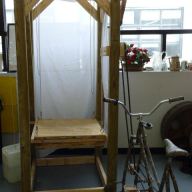Patrick Carr has spent almost his entire life in the elevator industry and up until last Friday, he was the founder and curator of the only elevator museum in the world based in Queens.
The Elevator Historical Society, located at 21-03 44th Ave. on the second floor of the Queens Medallion Leasing building in Long Island City, opened in 2011 and featured about 4,000 items that Carr has collected throughout his career.
Carr decided to close the museum, partly because the $5,000 to $6,000 rent price became too much and because he got no support from the elevator industry to run the museum.
“I’m not too happy with my peers,” Carr said. “It is our industry and if you don’t study your own history, you’re a fool.”
Now, his collection will be going to International Union of Elevator Constructors Local 4 in Boston, where the pieces will live in a 21,000-square-foot space.
“I’m pretty much not going to live forever,” Carr said. “My wife would not have a clue what to do with the collectibles. It was wise to basically do this, to get it out there and let someone else enjoy it.”
Carr was introduced to the industry by his father, an elevator mechanic, when he was around 11 years old and has stayed in the business ever since.
“[My dad] had a business on the side like a lot of guys did in the early 50s,” Carr said.
The Long Island City resident got his first official job in 1961 working to repair elevators for the city in public housing. He worked his way up and eventually became the vice president for what is now KONE, a leader in the elevator and escalator industry.
Carr, 72, is also the founder of several businesses including the former Century Elevator Maintenance Corporation and LIR Group, a personal injury consulting firm.
The museum, which was free to enter, featured a large collection of elevator parts and research materials. Some of the objects included molds to make elevator parts, oil cans, motors, car switches and more.
“I had this neat collection of really good stuff,” Carr said. “I couldn’t really see it sitting in storage someplace. I rented a space, it was originally a bit smaller than it is now, and started the museum.”
Though the museum acted as a place to preserve his items, Carr also used the space to educate people about the industry. He said the museum has had about 3,000 visitors in its five-year existence and he has been able to teach people about the elevator’s origins and try to alleviate some fears people have about the structures.
“It was to preserve it but it was also to supply a place where people could research,” Carr said. “I thought it was a great way of putting everything in one place.”
He said some frequently asked questions ranged from the safety of elevators to when the first elevator was operational.
“It depends on your definition of elevator,” Carr said.
Interior cranes were the first structures to carry goods and were powered at the end of the 18th century. The first passenger elevator was operational in 1835 in London, where it was called a lift or ascending room, according to Carr.
As for the safety of elevators, Carr argued that simple actions people take every day can be more dangerous.
“Can elevators be dangerous?” he said. “So can walking across the street.”
The New Yorker first reported the story.









































